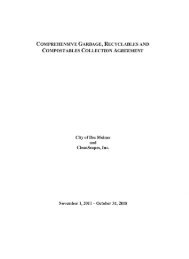CITY OF DES MOINES SHORELINE MASTER PROGRAM
CITY OF DES MOINES SHORELINE MASTER PROGRAM
CITY OF DES MOINES SHORELINE MASTER PROGRAM
You also want an ePaper? Increase the reach of your titles
YUMPU automatically turns print PDFs into web optimized ePapers that Google loves.
Des Moines Shoreline Inventory and Characterization<br />
(Table 4). Accretional areas are described portions of Segments A, D, E, F, and G. Stable<br />
sediments are documented in all of Segments B and C and within portions of Segments D, E, F,<br />
and G (WDNR, 2001). Shoreline activities that may impact beaches and backshores (KCDNR,<br />
2001) include:<br />
• Unnatural erosion or deposition of sediment;<br />
• Harvesting of shellfish and other marine life;<br />
• Fecal and chemical contamination;<br />
• Physical disturbances from shoreline armoring, marina construction, and upland<br />
development practices;<br />
• Shading from overwater structures; and<br />
• Loss of emergent and riparian vegetation to monoculture marshes.<br />
The WDNR ShoreZone Inventory utilized the British Columbia ShoreZone Mapping System,<br />
which classifies the shoreline into homogeneous stretches (or units) based on key physical<br />
controlling factors (WDNR, 2001). Table 7 summarizes the general beach or shoreline substrate<br />
composition, based on the British Columbia classification, for each shoreline planning segment<br />
(WDNR, 2001). A more detailed characterization for each segment, based on WDNR ShoreZone<br />
data, is found in Tables A-1 and A-4, Appendix A.<br />
Table 7. ShoreZone Classification (WDNR, 2001)<br />
Segment<br />
British Columbia Classification*<br />
A • Sand and gravel flat or fan<br />
B • Man-made, permeable<br />
C • Man-made, permeable<br />
• Sand and gravel flat or fan<br />
D • Sand and gravel flat or fan<br />
E • Sand and gravel flat or fan<br />
F • Sand and gravel flat or fan<br />
G • Sand and gravel flat or fan<br />
• Sand and gravel beach, narrow<br />
*British Columbia Physical Mapping System (Howes et al., 1994 in WDNR, 2001)<br />
Flats<br />
Flats generally include gently sloping sandy or muddy intertidal or shallow subtidal areas<br />
(KCDNR, 2001), and are used by juvenile salmonids, shorebirds, and shellfish, among other<br />
species. Flats are generally located at the mouths of streams where sediment transported<br />
downstream is deposited, and in areas of low wave and current energy where longshore waves<br />
and currents deposit sediment (KCDNR, 2001). Sand and gravel flats are mapped in all of<br />
Segments A, D, E, and F and portions of C and G (in the vicinity of the Des Moines, McSorley,<br />
Page 32 March 2005



